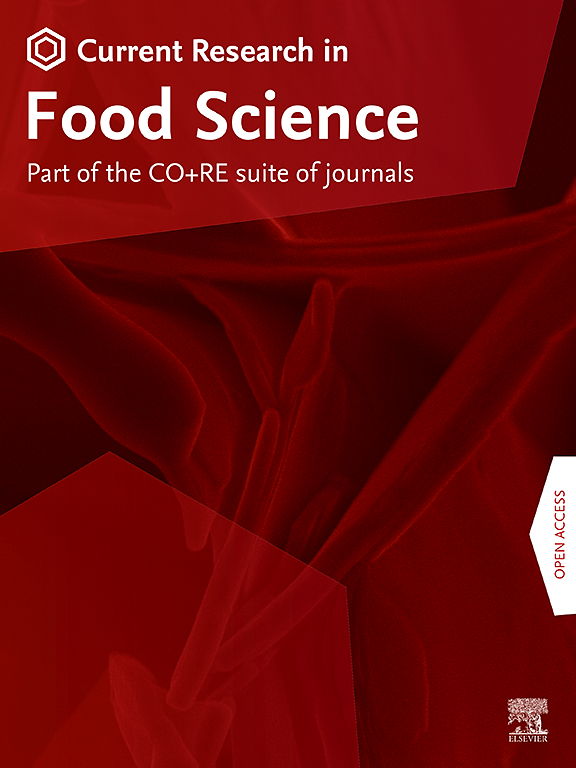Studying the impact of zein microfibers on the physicochemical and microstructural properties of bi-gels based on ι-carrageenan hydrogels and beeswax oleogels
IF 6.2
2区 农林科学
Q1 FOOD SCIENCE & TECHNOLOGY
引用次数: 0
Abstract
This research presents a novel bi-gel system formed by combining zein microfiber -reinforced carrageenan hydrogels and beeswax oleogels. The main objective is investigating the impact of the interplay between zein microfibers, ι-carrageenan hydrogels, beeswax oleogels on the properties of bi-gels. The study focused on bi-gel formulations combining beeswax oleogel and carrageenan, both plain and with zein microfibers. Different ratios of oleogel to ɩ-carrageenan hydrogel and oleogel to reinforced ɩ-carrageenan hydrogel were established: 5:95, 10:90, 15:85. The designed bi-gels exhibited semi-solid gel properties in rheological analysis, with increased oleogel content enhancing firmness, storage modulus, and loss modulus (G' < G″, p < 0.05). The incorporation of oleogel in the bi-gel substantially increased its consistency from 131 (g.s) to 668 (g.s) in the bi-gel containing 0.5% zein microfiber, 10% oleogel, and 90% hydrogel. FTIR results suggested that the bi-gels were formed through physical interactions without covalent cross-linking. Microfibers had a positive effect on the textural characteristics of bi-gels. The hardness of bi-gels increased from 13.26 to 35.12 g to 31-93-64.14 g after addition of microfibers. The BGZ10 formulation, consisting of 10% oleogel and 90% zein-reinforced hydrogel, showed the highest consistency among samples, with measurements of 668.48 ± 3.53 (g.s) and a G′ value of 291000 ± 91.27 (Pa) (P < 0.05). Additionally, the BGZ10 formulation displayed the highest complex viscosity, measuring at 47300 ± 20.73 (P < 0.05). The thermal stability of bigel considerably increased by cooperation fibers in hydrogel. The developed bi-gels demonstrate significant potential for substituting conventional solid fats and introducing distinctive visual characteristics in various food products.

研究了玉米蛋白微纤维对以ι-卡拉胶水凝胶和蜂蜡油凝胶为基础的双凝胶的理化和微观结构性能的影响
本研究提出了一种由玉米蛋白微纤维增强卡拉胶水凝胶和蜂蜡油凝胶组成的新型双凝胶体系。主要目的是研究玉米蛋白微纤维、ι-卡拉胶水凝胶、蜂蜡油凝胶之间的相互作用对双凝胶性能的影响。这项研究的重点是结合蜂蜡油凝胶和卡拉胶的双凝胶配方,包括普通的和含有玉米蛋白微纤维的。分别确定了油凝胶与磁-卡拉胶水凝胶和油凝胶与增强磁-卡拉胶水凝胶的比例:5:95,10:90,15:85。所设计的双凝胶在流变学分析中表现出半固体凝胶的特性,增加的油凝胶含量提高了硬度、储存模量和损失模量(G' <;G″,p <;0.05)。在含有0.5%玉米蛋白微纤维、10%油凝胶和90%水凝胶的双凝胶中,油凝胶的掺入大大增加了双凝胶的浓度,从131 (g.s)增加到668 (g.s)。FTIR结果表明,双凝胶是通过物理相互作用形成的,没有共价交联。微纤维对双凝胶的结构特性有积极的影响。添加微纤维后,双凝胶的硬度由13.26 ~ 35.12 g提高到31 ~ 93 ~ 64.14 g。由10%的油凝胶和90%的玉米蛋白增强水凝胶组成的BGZ10配方在样品之间的一致性最高,测量值为668.48±3.53 (G .s), G '值为291000±91.27 (Pa) (P <;0.05)。此外,BGZ10配方的复合粘度最高,测量值为47300±20.73 (P <;0.05)。水凝胶中配合纤维的加入大大提高了凝胶的热稳定性。所开发的双凝胶在替代传统固体脂肪和在各种食品中引入独特的视觉特性方面显示出巨大的潜力。
本文章由计算机程序翻译,如有差异,请以英文原文为准。
求助全文
约1分钟内获得全文
求助全文
来源期刊

Current Research in Food Science
Agricultural and Biological Sciences-Food Science
CiteScore
7.40
自引率
3.20%
发文量
232
审稿时长
84 days
期刊介绍:
Current Research in Food Science is an international peer-reviewed journal dedicated to advancing the breadth of knowledge in the field of food science. It serves as a platform for publishing original research articles and short communications that encompass a wide array of topics, including food chemistry, physics, microbiology, nutrition, nutraceuticals, process and package engineering, materials science, food sustainability, and food security. By covering these diverse areas, the journal aims to provide a comprehensive source of the latest scientific findings and technological advancements that are shaping the future of the food industry. The journal's scope is designed to address the multidisciplinary nature of food science, reflecting its commitment to promoting innovation and ensuring the safety and quality of the food supply.
 求助内容:
求助内容: 应助结果提醒方式:
应助结果提醒方式:


